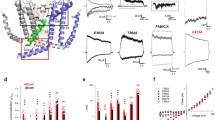Abstract
MEMBRANE depolarization causes many kinds of ion channels to open, a process termed activation1. For both Na+ channels2–4 and Ca2+ channels5,6, kinetic analysis of current has suggested that during activation the channel undergoes several conformational changes before reaching the open state. Structurally, these channels share a common motif7: the central element is a large polypeptide with four repeating units of homology (repeats I-IV), each containing a voltage-sensing region, the S4 segment8–11. This suggests that the distinct conformational transitions inferred from kinetic analysis may be equated with conformational changes of the individual structural repeats8. To investigate the molecular basis of channel activation, we constructed complementary DNAs encoding chimaeric Ca2+ channels in which one or more of the four repeats of the skeletal muscle dihydropyridine receptor are replaced by the corresponding repeats derived from the cardiac dihydropyridine receptor. We report here that repeat I determines whether the chimaeric Ca2+ channel shows slow (skeletal muscle-like) 12 or rapid (cardiac-like) 13 activation.
Similar content being viewed by others
References
Hille, B. Ionic Channels of Excitable Membranes (Sinauer Associates, Sunderland, Massachusetts, 1984).
Hodgkin, A. L. & Huxley, A. F. J. Physiol., Lond. 117, 500–544 (1952).
Armstrong, C. M. Physiol. Rev. 61, 644–683 (1981).
Keynes, R. D., Greeff, N. G. & Forster, I. C. Proc. R. Soc. Lond. B 240, 411–423 (1990).
Kostyuk, P. G., Krishtal, O. A. & Pidoplichko, V. I. J. Physiol., Lond. 310, 403–421 (1981).
Sanchez, J. A. & Stefani, E. J. Physiol., Lond. 337, 1–17 (1983).
Numa, S. Harvey Lect. 83, 121–165 (1989).
Noda, M. et al. Nature 312, 121–127 (1984).
Noda, M. et al. Nature 320, 188–192 (1986).
Tanabe, T. et al. Nature 328, 313–318 (1987).
Stühmer, W. et al. Nature 339, 597–603 (1989).
Tanabe, T., Beam, K. G., Powell, J. A. & Numa, S. Nature 336, 134–139 (1988).
Tanabe, T., Mikami, A., Numa, S. & Beam, K. G. Nature 344, 451–453 (1990).
Tanabe, T., Beam, K. G., Adams, B. A., Niidome, T. & Numa, S. Nature 346, 567–569 (1990).
Gluecksohn-Waelsch, S. Science 142, 1269–1276 (1963).
Zagotta, W. N. & Aldrich, R. W. J. gen. Physiol. 95, 29–60 (1990).
Mikami, A. et al. Nature 340, 230–233 (1989).
Noda, M., Suzuki, H., Numa, S. & Stühmer, W. FEBS Lett. 259, 213–216 (1989).
MacKinnon, R. & Miller, C. Science 245, 1382–1385 (1989).
MacKinnon, R. & Yellen, G. Science 250, 276–279 (1990).
Yool, A. J. & Schwarz, T. L. Nature 349, 700–704 (1991).
Yellen, G., Jurman, M. E., Abramson, T. & MacKinnon, R. Science 251, 939–942 (1991).
Hartmann, H. A. et al. Science 251, 942–944 (1991).
Guy, H. R. & Conti, F. Trends Neurosci. 13, 201–206 (1990).
Mishina, M. et al. Nature 307, 604–608 (1984).
Adams, B. A., Tanabe, T., Mikami, A., Numa, S. & Beam, K. G. Nature 346, 569–572 (1990).
Hamill, O. P., Marty, A., Neher, E., Sakmann, B. & Sigworth, F. J. Pflügers Arch. 391, 85–100 (1981).
Author information
Authors and Affiliations
Rights and permissions
About this article
Cite this article
Tanabe, T., Adams, B., Numa, S. et al. Repeat I of the dihydropyridine receptor is critical in determining calcium channel activation kinetics. Nature 352, 800–803 (1991). https://doi.org/10.1038/352800a0
Received:
Accepted:
Issue Date:
DOI: https://doi.org/10.1038/352800a0
- Springer Nature Limited
This article is cited by
-
Divergent biophysical properties, gating mechanisms, and possible functions of the two skeletal muscle CaV1.1 calcium channel splice variants
Journal of Muscle Research and Cell Motility (2011)
-
Reciprocal dihydropyridine and ryanodine receptor interactions in skeletal muscle activation
Journal of Muscle Research and Cell Motility (2011)
-
Ca2+/CaM-dependent inactivation of the skeletal muscle L-type Ca2+ channel (Cav1.1)
Pflügers Archiv - European Journal of Physiology (2008)
-
Enhanced dihydropyridine receptor channel activity in the presence of ryanodine receptor
Nature (1996)
-
Periodic paralysis and voltage-gated ion channels
Kidney International (1996)





